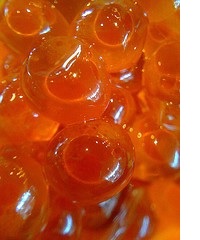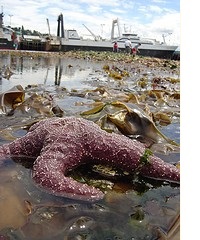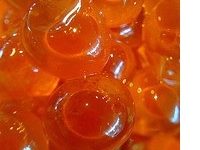Editor’s Note: This is the fourth installment in a series of posts looking into some of the the chemical pollutants that have contaminated Puget Sound’s fish and wildlife and pose one of the greatest threats to their survival. This is the first of two posts examining the effects of hormone-disrupting chemicals (including BPA) on the Sound.
By now, it’s clear to most of us that Puget Sound, despite its appearance, is not the pristinely clean water body we would wish for. But often, tracking down the exact impacts of the toxic alphabet soup of PCBs, phthalates, flame retardants, and other chemicals is nearly impossible.
To get a better handle on the real impacts, local scientists are trying a different approach—taking stock of how fish and wildlife are harmed, then tracking it back to toxic pollution. One place they’ve already started is hormone disruption, and one question they are pursuing is whether the Sound’s fish populations are able to reproduce normally.
Lyndal Johnson, a zoologist with NOAA Fisheries in Seattle, was one of the scientists that first noticed something was wrong with hormones in our local fish in the 1980s[1]. At that time, she and her colleagues were investigating the effects of PCBs and other chemicals. Johnson recounts, “we saw effects like delayed or inhibited gonadal [sex organ] development in females and lower levels of estradiol. When we brought the fish back into the lab, they tended to have problems spawning and the egg quality was not as good.”

At the same time, researchers in England were finding that chemicals in wastewater were having a feminizing effect on fish[2]. These studies relied on the fact that female fish need to produce eggs, not males, and only female fish should be making the building blocks for eggs. It turns out, however, that once exposed to hormone disrupting chemicals, male fish actually produce an egg yolk protein called vitellogenin. Researchers have used this fact to design a monitoring program that measures hormone disruption by looking for vitellogenin in male fish.
As part of their biennial sampling in the Puget Sound Assessment and Monitoring Program, Washington Department of Fish & Wildlife and NOAA Fisheries have tested the flatfish English sole for evidence of hormone disruption. To look for this evidence, they measured levels of vitellogenin in male fish throughout Puget Sound.

Indeed, flatfish in more polluted areas in Puget Sound are more likely to show signs of feminization: about a third of Elliot Bay’s male English sole, for example, are producing vitellogenin[3]. Moreover, in the three areas with the highest rates of this feminization, most of the female fish showed signs of disruption in their reproduction.
According to Johnson, “Spawning tended to be delayed, especially in the females. They would have their eggs later in the season when the rest of the fish around Puget Sound had completed spawning.” This delayed spawning could ultimately result in less successful reproduction.
Unfortunately, the phenomenon is not limited to the flatfish that live on the floor of the Sound. The researchers have also tested juvenile salmon, fish that also should not be producing egg proteins, and found that those living near high inputs of stormwater and wastewater also produce vitellogenin.
Photo attributions:
Fish egg image courtesy of Flickr user Belltown Messenger.
Seastar image courtesy of Flicr user Sikachu.
- Johnson, L., JT Landahl, LA Kubin, BH Horness, MS Myers, TK Collier, and JE Stein, Assessing the effects of anthropogenic stressors on Puget Sound flatfish populations. Journal of Sea Research, 1998: p. 125-137.
- Harries, J., DA Sheahan, S Jobling, P Matthiessen, P Neall, JP Sumpter, T Taylor, and N Zaman, Estrogenic activity in five United Kingdom rivers detected by measurement of vitellogenesis in caged male trout. Environmental Toxicology and Chemistry, 1997. 16(3): p. 534-542.
- Johnson, L., DP Lomax, MS Meyers, OP Olson, SY Sol, SM O’Neill, J West, and TK Collier, Xenoestrogen exposure and effects in English sole (Parophrys vetulus) from Puget Sound, WA. Aquatic Toxicology, 2008. 88: p. 29-38.




